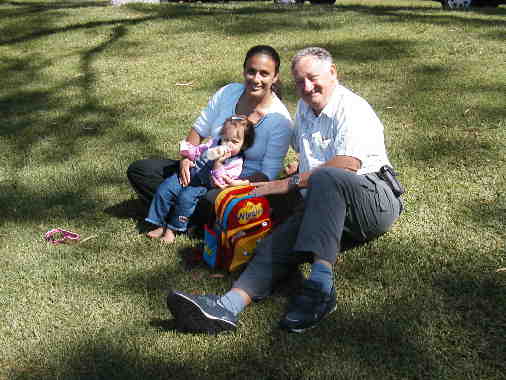
PERTH & WESTERN AUSTRALIA
9 April 2002 to 18 April 2002
Doreen writes:
We arrived in Perth after flying in from Ayers Rock. We were fully aware that the Australian leg of our trip was drawing to an end. We booked into City Waters Motel close to the Swan River, something of a dump but situated close to town. The first thing we noted about Perth is that it is quiet and that there are hardly any cars. We later learnt that all busses and trains within the inner city of Perth are free. At last, a city doing something positive to reduce traffic in towns with noticeable results.
The next morning Simona Gringart with her baby daughter Gaia showed us around town. Simona is a friend of Vered’s from their first days at high school in Eilat. We went to King’s Park with its beautiful views of the city. In the park there is a memorial to soldiers who lost their lives fighting overseas. We were surprised to see a memorial nearby dedicated to Jewish soldiers who lost their life in WWI, erected by the Hebrew Congregation. When Gaia woke up we sat on the grass just talking.

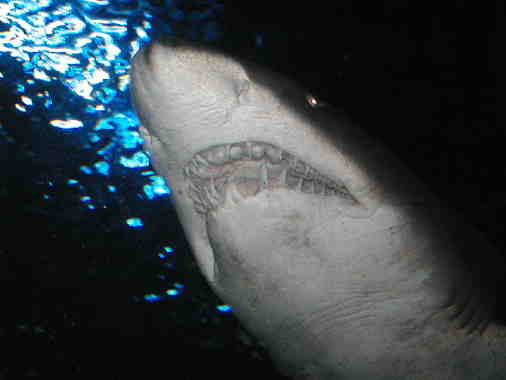 After a delicious
dimsum lunch Simona dropped us at AQWA - Aquarium of Western Australia
(Coral World). We were shown around and thoroughly enjoyed the visit.
After a delicious
dimsum lunch Simona dropped us at AQWA - Aquarium of Western Australia
(Coral World). We were shown around and thoroughly enjoyed the visit.
Unlike Eilat where all the fish are tropical, at AQWA the displays are
divided into tropical and temperate seas and an estuarine display, from
around Western Australia’s shores. The best was a tube-like aquarium
full of pulsating jellyfish, that looked like something out of a dream
sequence. Most dramatic was an acrylic tunnel that goes through a huge
aquarium with schools of fish, turtles, stingrays and sharks.
In the evening we went to Simona and Eyal for dinner. We were
delighted that Simona had become a lovely young woman and we
immediately liked Eyal. Vered must have told them we like to eat
because over the next few hours they proceeded to ply us with whisky
and wine and stuff us with course after course of delicious food until
we were reeling under strain of a serious food coma. On our last night
in Perth we saw Simona and Eyal again.
We had a few days free before we left for South Africa, so we hired
a car and drove southwards. It took us an hour to get out of Perth; we
had forgotten that their highways are full of traffic lights and
shopping centers and are not freeways.
Southwestern Australia is a huge wine-growing area. We drove to Mount
Barker and stopped at the Plantagenet winery. Since we know nothing
about Australian wines we’ve usually chosen either according to an
interesting label or the name. The Plantagenets was one of the first
television dramas to be screened over Israeli television some 30 years
ago. You knew that no matter what time you invited people over, they
would only start to come after that week’s episode.We later visited
another winery in the Margaret River area, Howard Park. It was the name
and label of their table wine Mad Fish that attracted us.
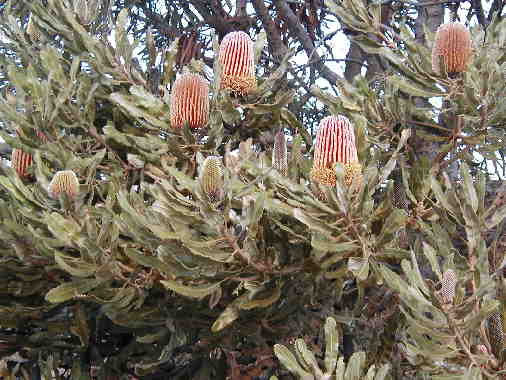 Before
driving on to Albany we visited a Banksia farm, the ‘people’ trees we
like so much. The owner Kevin manages to grow all 76 species of banksia
and gives a fascinating tour of these bushes, from the same
family as proteas, macadamias, grevillae and dryandras. Kevin spoke of
the strategies of the banksia to ensure good germination. Most need
fire to open the seedpods so the winged seeds can be released, but will
do so only after the nutrient-rich ash cools. To ensure germination
some release their seeds only after repeated rains to prevent the seeds
drying out after an unseasonal thunderstorm. We bought some seeds in
the vain hope that we will be able to get them to grow.
Before
driving on to Albany we visited a Banksia farm, the ‘people’ trees we
like so much. The owner Kevin manages to grow all 76 species of banksia
and gives a fascinating tour of these bushes, from the same
family as proteas, macadamias, grevillae and dryandras. Kevin spoke of
the strategies of the banksia to ensure good germination. Most need
fire to open the seedpods so the winged seeds can be released, but will
do so only after the nutrient-rich ash cools. To ensure germination
some release their seeds only after repeated rains to prevent the seeds
drying out after an unseasonal thunderstorm. We bought some seeds in
the vain hope that we will be able to get them to grow.
We slept at Albany and the following morning we retraced our steps and went to Mt Romance sandalwood factory. Sandalwood is a semi-parasitic tree that has its own roots but supplements its needs from a host tree. India supplies sandalwood oil for perfumes like Samsara, Calvin Klein and Opium but have issued a moratorium on cutting trees. The biggest resource is now Western Australia where it is grown specifically to harvest. It is a small tree, about 4 meters high and the whole tree is uprooted and shredded. Sandalwood mixed with resin is extracted and then the sandalwood oil is separated. Sandalwood is supposed to have many therapeutic effects that include reducing high blood pressure and effectively acting on candida and psoriasis. It works on the limbic part of the brain so that inhaling deeply and slowly is supposed to relax, calm and slow the blink rate. We did put a little oil on a silk scarf, rubbed the scarf to warm the oil and then inhaled slowly and deeply and felt different, so of course we bought a bottle and a scarf!
Afterwards we returned to Albany and drove up to Clarence Hill for a nice view of the harbour. The crest is called Anzac Hill with a fine statue of a man and two horses. It originally stood at Port Said commemorating Australian and New Zealand participation in WWI from 1916-1918. During the Suez campaign it was damaged and the masonry was moved to its present site and a replica of the statue was made.
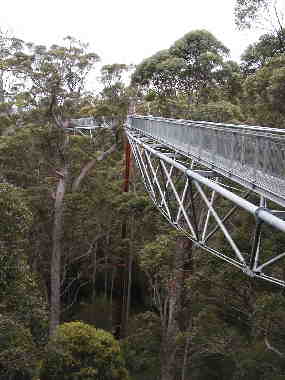 We then drove
westward and just before Walpole we stopped at the TreeTops Walk. A
steel boardwalk suspended 40 meters above the ground winds between 3
species of rare eucalypts that are endemic to this area and occur
nowhere else – red and yellow and Rates tingle trees as well as giant
karris, some reaching 60 meters high. It was nice to view the tree tops
from their height. A smell of tomcat pervades the area; it is the scent
of a karri wattle tree. Afterwards, walking on the ground we
examined tingle trees that continue to grow even though their centers
were eaten away by fire, fungus and termites.
We then drove
westward and just before Walpole we stopped at the TreeTops Walk. A
steel boardwalk suspended 40 meters above the ground winds between 3
species of rare eucalypts that are endemic to this area and occur
nowhere else – red and yellow and Rates tingle trees as well as giant
karris, some reaching 60 meters high. It was nice to view the tree tops
from their height. A smell of tomcat pervades the area; it is the scent
of a karri wattle tree. Afterwards, walking on the ground we
examined tingle trees that continue to grow even though their centers
were eaten away by fire, fungus and termites.
We stopped at Warren National Park and drove through virgin karri forest to the centennial tree. There are a number of trees in the area that can be climbed and this one is the highest. It has pegs circling the living tree to the top. I climbed about 5 meters for a photograph then looked down and decided that I really didn’t want to do this and climbed back down. While we sat and agreed that it was ridiculous to do it, I looked again and decided that actually I could do it. I would not have done it if it were objectively dangerous, like raining or wet or windy. But when the fear is only in the mind I like to challenge that fear and try to overcome it. Although the rungs that are vertical look quite forbidding it is the spaced rungs that are harder to negotiate. Seventy five meters up a tree is very high and in all directions the treetops were below the platform. There is no photograph from up there, as I didn’t want my camera to get entangled in the spokes. My thighs ached for days afterwards.

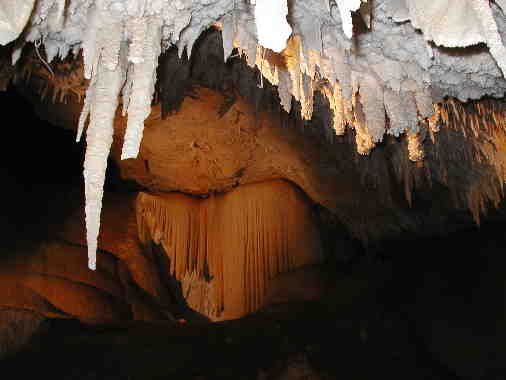
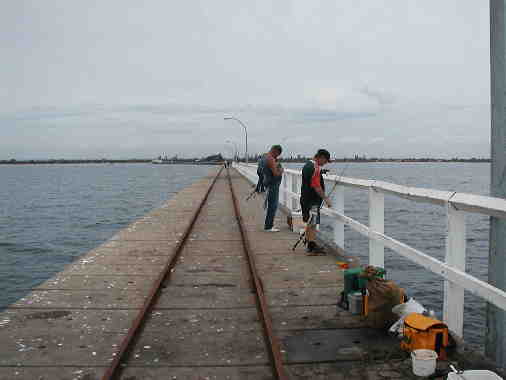 When we reached the
southwesterly point of Australia we turned northward and made our way
back to Perth. At Busselton we walked the 2 km-long jetty. The
water was very clear and we could see swarms of pilchards and herrings
on either side of the jetty. Sometimes whole schools broke the surface
making a really loud sucking sound. No one could explain why they
did it. We walked slowly along chatting to the eager fishermen and had
a most pleasant time.
When we reached the
southwesterly point of Australia we turned northward and made our way
back to Perth. At Busselton we walked the 2 km-long jetty. The
water was very clear and we could see swarms of pilchards and herrings
on either side of the jetty. Sometimes whole schools broke the surface
making a really loud sucking sound. No one could explain why they
did it. We walked slowly along chatting to the eager fishermen and had
a most pleasant time.
Our last stop was at Lake Clifton in Yalgorup National Park. There
were many kangaroos about and I narrowly missed one that suddenly
jumped into the road. Thank goodness we got through our trip without
killing a kangaroo!
After reading the billboard at the interpretative center, we walked
along the boardwalk and saw thrombolites, like little beehives in the
water. Looking more closely we could see purple rock-like things
floating in the water. But rocks don’t float. A couple arrived and they
too were looking at the water. 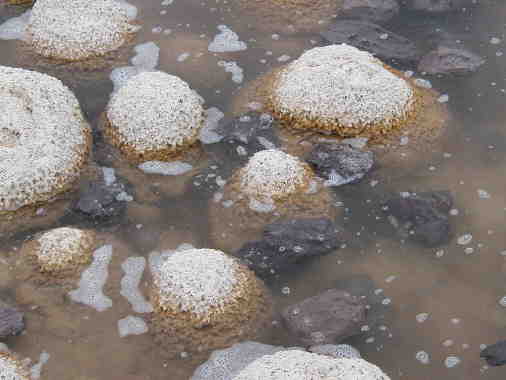 They lived just down
the road and had never seen these floating things. He was a geologist.
He jumped onto a thrombolite (ignoring the signs) and picked up one of
these stones. It was smooth like jelly and broke very easily. It had a
slight sulfur smell but was not unpleasant. We learnt that the lake was
unusually low and that besides rain, it has no other source of water;
it was cut off from the sea in the Ice Age. The geologist told us that
a group of German scientists had visited recently and taken many
samples of the waters. Back at the billboard we reread the information
and decided that what we saw was one of the stages in the formation of
stromatolites, a modern example of an ancient life form.
They lived just down
the road and had never seen these floating things. He was a geologist.
He jumped onto a thrombolite (ignoring the signs) and picked up one of
these stones. It was smooth like jelly and broke very easily. It had a
slight sulfur smell but was not unpleasant. We learnt that the lake was
unusually low and that besides rain, it has no other source of water;
it was cut off from the sea in the Ice Age. The geologist told us that
a group of German scientists had visited recently and taken many
samples of the waters. Back at the billboard we reread the information
and decided that what we saw was one of the stages in the formation of
stromatolites, a modern example of an ancient life form.
On our last night in Perth we invited Simona and Eyal and Oren and Nitzan Lifshitz out for dinner. Oren is presently the curator at AQWA and used to work at Coral World Eilat. It was our Yom Ha-azmaut celebration. We expressed hopes of peace and safety for all those back home, toasted Israel in Hebrew as we ate at a Lebanese restaurant. We wished things could be so simple back home.
